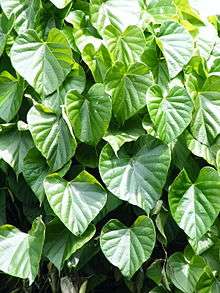Tinospora cordifolia
Tinospora cordifolia, which is known by the common names heart-leaved moonseed, guduchi, and giloy, is an herbaceous vine of the family Menispermaceae indigenous to tropical regions of the Indian subcontinent.[1] Despite centuries of use in traditional medicine to treat various disorders, there is no high-quality clinical evidence that it has any effect on diseases.[1]
| Tinospora cordifolia | |
|---|---|
 | |
| Scientific classification | |
| Kingdom: | Plantae |
| Clade: | Tracheophytes |
| Clade: | Angiosperms |
| Clade: | Eudicots |
| Order: | Ranunculales |
| Family: | Menispermaceae |
| Genus: | Tinospora |
| Species: | T. cordifolia |
| Binomial name | |
| Tinospora cordifolia (Thunb.) Miers | |
Botanical description
It is a large, deciduous, extensively-spreading, climbing shrub with several elongated twining branches. Leaves are simple, alternate, and exstipulate with long petioles up to 15 cm (6 in) long which are roundish and pulvinate, both at the base and apex with the basal one longer and twisted partially and half way around. Lamina are broadly ovate or ovate cordate, 10–20 cm (4–8 in) long or 8–15 cm (3–6 in)broad, seven nerved and deeply cordate at base, membranous, pubescent above, whitish tomentose with a prominent reticulum beneath. Flowers are unisexual, small on separate plants and appearing when plant is leafless, greenish yellow on axillary and terminal racemes. Male flowers are clustered, but female flowers are usually solitary. It has six sepals in two series of three each. The outer ones are smaller than the inner. It has six petals which are smaller than sepals, obovate, and membranous. Fruits aggregate in clusters of one to three. They are ovoid smooth drupelets on thick stalks with sub terminal style scars, scarlet or orange colored.[2]
Phytochemicals
Tinospora contains diverse phytochemicals, including alkaloids, phytosterols, glycosides, and mixed other chemical compounds.[1] Columbin, tinosporaside, jatrorhizine, palmatine, berberine,[3] tembeterine, tinocordifolioside, phenylpropene disaccharides, choline, tinosporic acid, tinosporal, and tinosporon have been isolated from Tinospora cordifolia.[1]
Ecology
Endophytic fungi colonize the living, internal tissues of their host without causing any harmful effects. A recent study has shown that 29 endophytes belonging to different taxa were present in the samples collected from T. cordifolia.[4]
Extracts of the endophytic fungus Nigrospora sphaerica obtained from T. cordifolia were found to have insecticidal properties against the Oriental leafworm moth (Spodoptera litura), a polyphagous pest.[5]
Uses
Traditional medicine
In Ayurveda and Siddha medicine, Tinospora has been used over centuries to treat various diseases.[1] Due to inadequate design or other limitations of clinical research on Tinospora, there is no high-quality scientific evidence that it affects any disease, and it is not used as a prescription drug.[1]
References
- "Tinospora". Drugs.com. 15 July 2019. Retrieved 5 September 2019.
- Sinha, Kirti; Mishra, N P; Singh, J; Khanuja, S P S (July 2004). "Tinospora cordifolia (Guduchi), a reservoir plant for therapeutic applications: A Review". Indian Journal of Traditional Knowledge. 3 (3): 257–70.
- Mohan, Mohind C.; Abhimannue, Anu P.; Kumar B, Prakash (15 April 2017). "Identification and Characterization of Berberine in Tinospora cordifolia by Liquid Chromatography Quadrupole Time of Flight Mass Spectrometry (LC MS/MS Q-tof) and Evaluation of its anti Inflammatory Potential". Pharmacognosy Journal. 9 (3): 350–355. doi:10.5530/pj.2017.3.59.
- Mishra, Ashish; Gond, Surendra K.; Kumar, Anuj; Sharma, Vijay K.; Verma, Satish K.; Kharwar, Ravindra N.; Sieber, Thomas N. (2012). "Season and Tissue Type Affect Fungal Endophyte Communities of the Indian Medicinal Plant Tinospora cordifolia More Strongly than Geographic Location". Microbial Ecology. 64 (2): 388–98. doi:10.1007/s00248-012-0029-7. PMID 22430503.
- Thakur, Abhinay; Kaur, Sanehdeep; Kaur, Amarjeet; Singh, Varinder (2012). "Detrimental effects of endophytic fungus Nigrospora sp. on survival and development of Spodoptera litura". Biocontrol Science and Technology. 22 (2): 151–61. doi:10.1080/09583157.2011.646952.